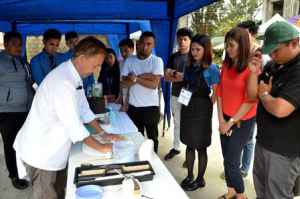Philex leads 4th PH-EITI report on envi, social projects implementation
TUBA, BENGUET – Philex Mining Corp. has expressed support for calls by a global-standard organization for government, rather than miners, to shoulder the monitoring activities of multipartite teams, as the gold-and-copper producer topped the country’s metallic mining sector in the implementation of projects on environmental protection and social development.
“Yes, it should be the government that would allot funds for it,” Eduardo Aratas, manager of the Legal Div., in this province’s Padcal operations, Philex Mining’s sole operating mine, said.
This was in reaction to the latest report of the Philippine Extractive Industries Transparency Initiative (PH-EITI), which has recommended that, among other things, the regular watch conducted by the multipartite monitoring teams (MMTs) on mining companies be “financed by government funds released through the MGB, not mining companies directly.”
Addressing the MGB, or Mines and Geosciences Bureau, a government agency that regulates the mining industry, the PH-EITI also recommended to “[s]tudy the possibility of widening public sector and academic participation” in the enhancement of existing guidelines for MMTs and MRFCs, or Mine Rehabilitation Fund Committees.
Launched Wednesday, April 18, at the PICC Complex, in Metro Manila’s Pasay City, The Fourth PH-EITI Report: Moving Beyond Transparency, which covers the fiscal years 2015 and 2016, listed Philex Mining as among the “top miners” in environmental protection and social development based on the reports submitted by the participating miners. PH-EITI’s respective third, second, and first reports cover the fiscal years 2014, 2013, and 2012.
“The fourth report aims to provide updates on the legal framework and fiscal regime governing the oil and gas, mining, and coal industries,” said the 468-page report by the Norwegian-based nonprofit, EITI, which promotes the open and accountable management of oil, gas, and mineral resources. “It is expounded to cover the laws, policies, and issuances specifically governing the non-metallic mining industry.”
The latest PH-EITI report covers 28 metallic mining companies, seven non-metallic mining companies, five oil and gas companies, eight national agencies, and 61 local government units (LGUs) in 2015 and 2016.
The report likewise told the MGB, which operates under the Department of Environment and Natural Resources (DENR), to improve its monitoring and accuracy of production data. This can be done, it said, with the MGB-DENR doing its own regular assays of ore shipments and being present at a miner’s loading dock to check the volume of ore being shipped. It added that a standard format for this kind of monitoring has been created and is being evaluated by the MGB Policy Technical Working Group (PTWG).
The standardization of the MMT reports, on the other hand, has been addressed by the DENR Administrative Order (DAO) 2015-02 and the Republic Act 7942, otherwise known as the Philippine Mining Act of 1995, and is being adopted by all the country’s MMTs, which are preparing a manual of operations.
Carried out through its Social Development and Management Program (SDMP), Philex Mining implemented infrastructure projects to the tune of P259.34 million—described by the latest report as “cumulative costs to date” and listed under “Table 85. SDMP of participating metallic and non-metallic entities, 2016.” The total amount balloons to P348.14 million to include the P54.32 million for the Information, Education and Communications (IEC) campaign, and P34.48 million for the Development of Mining Technology and Geosciences (DMTG).
This compared to the P316.3 million and P232.47 million covering the respective total SDMP, IEC and DMTG of OceanaGold (Phils.), Inc. and of Carmen Copper Corp. for the same period, according to The Fourth PH-EITI Report.
A large-scale miner is mandated by the government to set aside 1.5 percent of its previous year’s total operating cost for the current year’s total budget for SDMP, IEC, and DMTG. Of this total share, 75 percent goes to the SDMP, which covers infra projects, 15 percent is for the IEC—information dissemination on the benefits derived from mining—and the remaining 10 percent is reserved for DMTG, which funds training, further studies, and research and development being undertaken by professionals for the improvement of the industry.
Philex Mining’s operating cost for 2015 amounted to P6.09 billion while OceanaGold (Phils.)’s reached P6.48 billion, and Carmen Copper’s was P8.83 billion—as mentioned by the latest PH-EITI report.
For 2015, Philex Mining has a “cumulative costs to date” of P239.14 million for its combined SDMP, IEC, and DMTG, while OceanaGold (Phils.) has P233.51 million and, Taganito Mining Corp., P119.9 million; the respective 2014 operating costs for the three companies are P6.72 billion, P6.35 billion, and P1.78 billion.
In environmental protection and rehabilitation, such as reforestation based on a miner’s reported Environmental Protection and Enhancement Program (EPEP) and disbursements from its Monitoring Trust Fund, Philex Mining led Carmen Copper, Taganito Mining, and Platinum Group Metals Corp. Some companies provided their total EPEP expenditures but without details.
Philex Mining spent P446.74 million for its annual EPEP (AEPEP) for 2016, as compared with Carmen Copper’s P411.68 million, Taganito Mining’s P144.72 million, and Platinum Group’s P101.88 million. For 2015, Philex Mining’s actual expenditure for AEPEP reached P270.95 million, while Carmen Copper registered P225.37 million, Taganito Mining posted P255.75 million, and Platinum Group had P110.4 million.
Referring to the comprehensive and strategic environmental-management plan for the life of the mine, EPEP requires an annual spending of 3-5 percent of a miner’s direct mine and milling costs for the same year. PR / ABN
Community Billboard
TB CARAVAN
April 22, 2024
MUNICIPAL EMPLOYEE’S COOPERATIVE, PAPALAWIGIN ANG SERBISYO
April 22, 2024
VEGETABLE TRADING
April 20, 2024
MAALAB NA PAGBATI!!!
April 20, 2024






